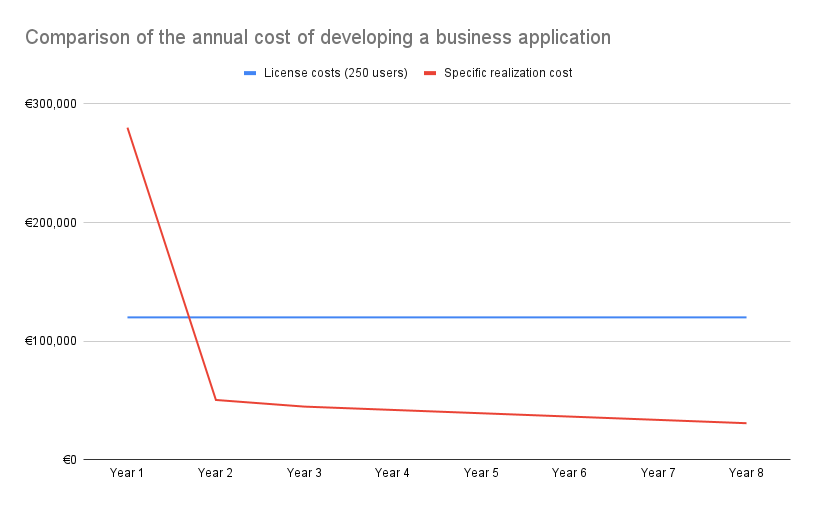What if digital autonomy came through tailor-made solutions? Smile advocates for specific, sovereign development, aligned with your real business challenges.
At a time when businesses are overwhelmed by a multitude of standardized digital tools, often in SaaS mode and published by non-European players, the promise of ease of use sometimes seems too good to be true. Yet, behind this apparent ease lies a crucial issue: loss of control, dependence on suppliers, and the gradual erosion of digital freedom.
The specific development of business applications, often perceived as a technical approach reserved for large companies, today appears to be a real strategic lever for regaining this freedom, mastering its tools and strengthening its digital autonomy.
For CIOs, CTOs and business decision-makers seeking to build coherent, efficient information systems aligned with their needs, the specific development of business applications is more than an option: it is a tailored response that fits perfectly with Smile's open source and sovereign DNA.
Standardization, subscriptions, dependencies – at what cost?
The market is brimming with SaaS solutions promising rapid integration, delegated maintenance, and simplified startup. This standardization, driven by major players, certainly facilitates access to powerful tools, but at what cost?
- Functional rigidity: generic SaaS solutions cannot always match business specificities.
- Stacking of tools: each department chooses its applications, which creates silos and multiplies interfaces.
- Vendor lock-in: monthly subscriptions, forced upgrades, proprietary locks.
- Poorly managed recurring costs: Subscription fees accumulate, sometimes without transparency or control. In a situation of publisher dependence, increases in licensing costs are regular and are borne by companies, which are often trapped by the complexity of changing solutions (full-fledged project, acculturation to a new tool, change of established processes, etc.).
- Loss of global vision: difficulty connecting data, increasing complexity, lack of agility.
- Loss of control over data: locations not always known, access to data possible by various state actors, risks linked to the use of data by unauthorized AI, etc.
The result? Fragmented management, unforeseen costs, and an information system that gradually becomes more of a hindrance than a lever, and above all, a gradual loss of corporate sovereignty.
What is specific development in concrete terms?
Custom development is the tailor-made design of digital business tools adapted to the unique needs of an organization. It doesn't necessarily mean starting from scratch, but rather building exactly what is useful, taking into account constraints, uses, and business objectives.
We can distinguish:
- The pure specific: creation of a business tool fully developed to meet a specific need. The organization generally becomes the full owner, which guarantees it total autonomy over the use, maintenance, development, or even resale of the software.
- Customizing existing tools: this involves adapting standard software to better fit internal processes while taking care not to modify the core of the tool.
- Extensions in open source frameworks: this approach allows you to maintain full control of the code by adding or modifying features in a free and scalable base, unlike Vendor Lock-in. Here, an internal or third-party team can take over and evolve the produced code, without dependence on the initial publisher.
Intellectual property: manage your rights at the heart of digital tailor-made solutions
When developing specific business applications, intellectual property over the code represents a key strategic advantage. When a company holds full rights to the software developed, it can evolve it freely, without being dependent on a supplier or publisher. This provides a fully autonomous legal framework, guaranteeing freedom of action, technical scalability, and greater control over its digital tools. This control strengthens the agility, security, and sustainability of the organization's information systems.
Thus, by controlling the rights to its digital tools, the organization strengthens its digital sovereignty, while ensuring agility, scalability and autonomy.
What specific development really allows
Custom development of business applications is not limited to creating software: it also allows you to respond to complex and differentiating business challenges.
- Adapt to complex business logic: Some processes don't fit into standard solutions. Customization allows for the integration of these specific features. This means implementing only the features that users need, based on their rights level: this represents a significant gain in operational efficiency.
- Integrate tools harmoniously: by connecting the different building blocks of the digital ecosystem, we avoid the multiplication of friction points and preserve data integrity.
- Promote an optimized business user experience (UX): a tool designed for real users improves their engagement and productivity.
- Freely develop solutions without depending on a publisher;
- and, where appropriate, the possibility of promoting or sharing the developments made.
Thus, specific development allows the company to free itself from constraints, to be more agile and to better manage its activities.
At Smile , we design custom, interconnected applications built on modern architectures. Our goal: to transform your tools into real performance levers. Thanks to our unique collaborative approach, which combines the strategic vision of our consultants with the excellence of our UX/UI designers and the robustness of our solutions architects and experienced developers, we create applications that are not only technically efficient, but also perfectly adapted to the needs of your users.
"Tailor-made" does not mean overpriced
The specific development of business applications suffers from a preconceived idea: it is necessarily expensive and reserved for large companies. In reality, it is a question of total cost of ownership (TCO), generally evaluated over 5 years.
The initial cost may seem higher than that of a SaaS solution subscription, but in reality, it is often equivalent to the price of one or two years of licensing. The investment in the first year covers the complete implementation of the application. However, from the second year, expenses drop: the maintenance of a specific application generally represents only 10 to 15% of its initial cost. Conversely, licensed software continues to generate fixed, or even increasing, annual fees. Thus, over five years, a specific application has become significantly less expensive than licensed software. A specific business application, if it has been maintained via third-party application maintenance (TMA), is not obsolete after 5 years, but continues to function for up to 7 or even 10 years, which significantly strengthens the ROI and further improves the TCO curve.


Specific best-of-breed development allows the tool to evolve over time, based on actual uses and business needs, and thus maintain the tool at the best level of efficiency and use, avoiding dependence on a publisher's roadmap.
Hosting and support can be optimized thanks to open source: By relying on proven, widely distributed foundations, compatible with modern practices (containerization, FinOps, etc.), we limit costs while gaining flexibility.
When custom development relies on open source technologies, it becomes a controlled and sustainable investment. The open source model eliminates recurring licensing and subscription fees, allowing you to focus your budget on what matters most: user experience, key features, and integration with existing information systems.
Rather than starting from scratch, custom development leverages robust, existing building blocks to create a tailor-made solution designed to last. It's not a luxury, but a strategic, controlled, and sustainable choice, accessible to any organization concerned about its performance and digital independence.
The specific development of business applications as a tool for digital sovereignty
Beyond savings, custom development is a key lever for digital sovereignty:
- Data remains under control: controlled hosting, confidentiality assured.
- The code is free: it can be modified, adapted, and developed according to needs without depending on a third party.
- Technological independence: more risks associated with abrupt policy changes or product discontinuation.
- Strategic alignment: developments are decided internally, in line with business objectives.
This sovereignty is all the more strategic as security and data protection are major priorities in Europe for applications linked to “core business” activities.
Conclusion: tailor-made as a strategic approach
Specific development is no longer a marginal option or a simple technical alternative. It is a considered choice, an act of sovereignty and digital ambition.
In a world where tools are similar, where standard solutions create uniformity and dependency, tailor-made solutions offer a precious freedom: that of building a coherent, best-of-breed, efficient information system that truly serves businesses.
For decision-makers, it is an invitation to rethink the way they approach their digital transformation, with a strong underlying promise: rediscovered digital freedom.
Regain control of your information system with specific development
No longer be limited by the limitations of standardized solutions. Opt for custom development for your business applications, aligned with your core business, your sovereignty, and your ambitions.
At Smile, we design robust, scalable business applications that are perfectly suited to your ecosystem.


